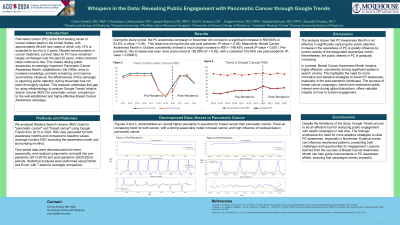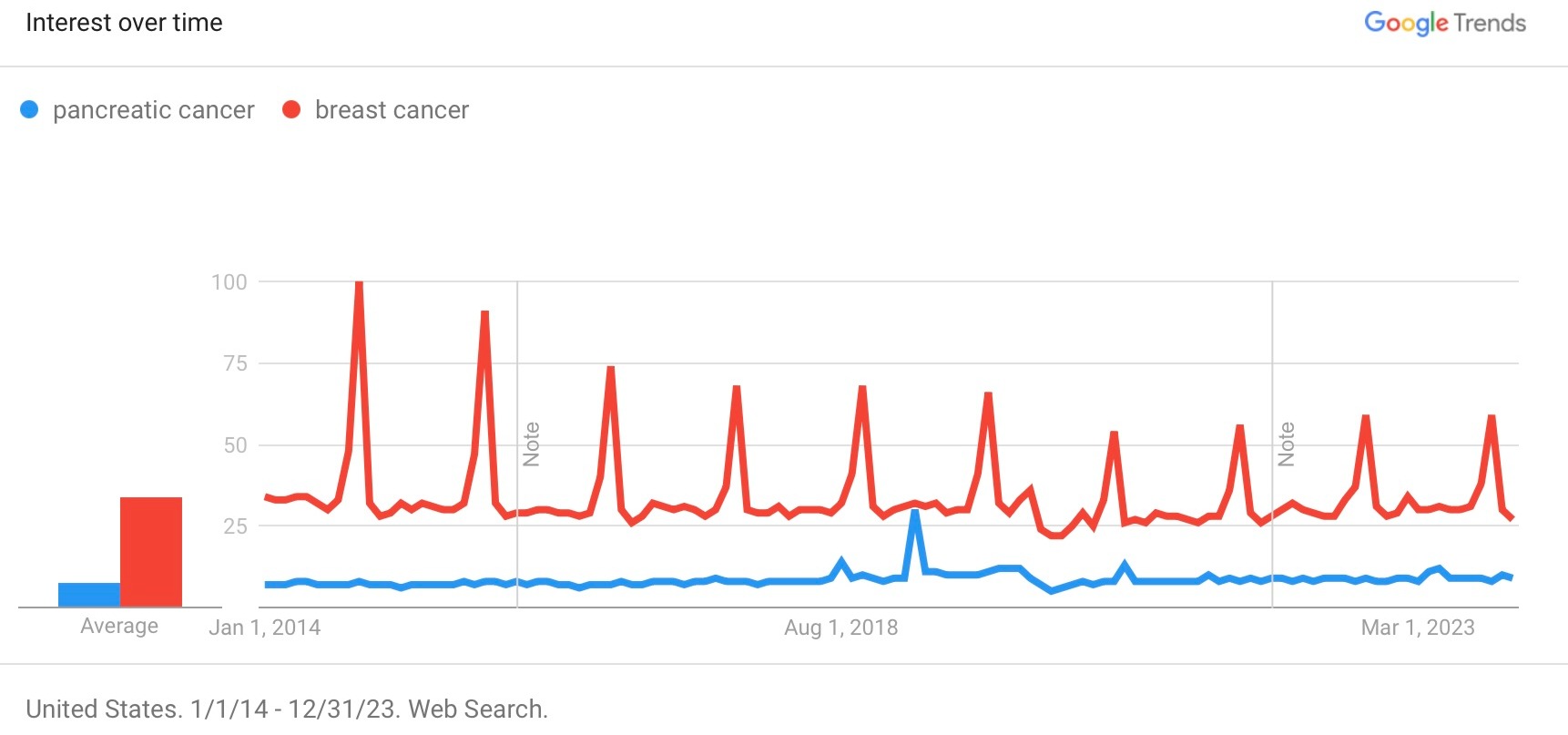Sunday Poster Session
Category: Biliary/Pancreas
P0013 - Whispers in the Data: Revealing Public Engagement With Pancreatic Cancer through Google Trends
Sunday, October 27, 2024
3:30 PM - 7:00 PM ET
Location: Exhibit Hall E

Has Audio
- CA
Chima Amadi, MD, MBA
Morehouse School of Medicine
Atlanta, GA
Presenting Author(s)
Chima Amadi, MD, MBA1, Oluwatayo J. Awolumate, MD2, Adedeji Adenusi, MD, MPH3, Joseph Atarere, MD, MPH4, Toni M. Jackson, DO5, Eugene Annor, MD, MPH6, Saurabh Chawla, MD7
1Morehouse School of Medicine, Atlanta, GA; 2Howard University Hospital, Washington, DC; 3One Brooklyn Health-Interfaith Medical Center, Brooklyn, NY; 4MedStar Union Memorial Hospital, Baltimore, MD; 5Morehouse School of Medicine, Far Rockaway, NY; 6University of Illinois College of Medicine, Morton, IL; 7Emory University School of Medicine, Atlanta, GA
Introduction: While modern medicine has made incredible leaps in improving the survival rates of many cancers, pancreatic cancer remains an exception. It is the third most lethal cancer in the United States, and its incidence rate is rising. This makes awareness of the disease even more crucial. Pancreatic Cancer Awareness Month began in the 2000s to increase public knowledge, promote screening, and boost survivorship. However, the effectiveness of this campaign in capturing public attention during November has yet to be explored. This study aims to fill that gap by using infodemiology to analyze Google Trends' relative search volume (RSV) for pancreatic cancer and compare it to the well-established Breast Cancer Awareness campaign, which is known for effectively capturing public interest.
Methods: A temporal analysis of RSV for the terms "pancreatic cancer" and "breast cancer" was obtained from Google Trends for 2014 to 2023. The baseline annual RSV for each cancer was calculated, excluding the awareness month and the month before and after. This baseline RSV was then compared to the cancer-specific awareness month RSV. Additionally, the data was further segmented into pre-pandemic (2014-2019) and post-pandemic (2020-2023) periods to identify any shifts in awareness patterns. Data was analyzed using a t-test.
Results: This study highlights the significant impact of Breast Cancer Awareness Month, as seen in Figure 1. This campaign consistently led to a notable increase in RSV for breast cancer in October each year during the study period, with an average RSV of 33 rising to 80 (t-test p-value < 0.005). In contrast, in November, pancreatic cancer awareness campaigns had a less pronounced effect, with an average RSV of 60 increasing slightly to 63.5 (t-test p-value > 0.05).
When comparing pre-pandemic and post-pandemic periods, the RSV for breast cancer in October showed a persistent increase, from 28 to 79 pre-pandemic and 39 to 81 post-pandemic (t-test p-value < 0.005). Meanwhile, the RSV for pancreatic cancer showed no significant change, from 59.7 to 63.8 pre-pandemic and 60.2 to 63.1 post-pandemic (t-test p-value > 0.05).
Discussion: Pancreatic cancer awareness month did not significantly increase its RSV, whereas Breast Cancer Awareness Month consistently increased its RSV. While additional metrics are needed to evaluate the efficacy of public health campaigns, the current data suggest the need for new approaches to generate public interest in pancreatic cancer during its awareness month.

Disclosures:
Chima Amadi, MD, MBA1, Oluwatayo J. Awolumate, MD2, Adedeji Adenusi, MD, MPH3, Joseph Atarere, MD, MPH4, Toni M. Jackson, DO5, Eugene Annor, MD, MPH6, Saurabh Chawla, MD7. P0013 - Whispers in the Data: Revealing Public Engagement With Pancreatic Cancer through Google Trends, ACG 2024 Annual Scientific Meeting Abstracts. Philadelphia, PA: American College of Gastroenterology.
1Morehouse School of Medicine, Atlanta, GA; 2Howard University Hospital, Washington, DC; 3One Brooklyn Health-Interfaith Medical Center, Brooklyn, NY; 4MedStar Union Memorial Hospital, Baltimore, MD; 5Morehouse School of Medicine, Far Rockaway, NY; 6University of Illinois College of Medicine, Morton, IL; 7Emory University School of Medicine, Atlanta, GA
Introduction: While modern medicine has made incredible leaps in improving the survival rates of many cancers, pancreatic cancer remains an exception. It is the third most lethal cancer in the United States, and its incidence rate is rising. This makes awareness of the disease even more crucial. Pancreatic Cancer Awareness Month began in the 2000s to increase public knowledge, promote screening, and boost survivorship. However, the effectiveness of this campaign in capturing public attention during November has yet to be explored. This study aims to fill that gap by using infodemiology to analyze Google Trends' relative search volume (RSV) for pancreatic cancer and compare it to the well-established Breast Cancer Awareness campaign, which is known for effectively capturing public interest.
Methods: A temporal analysis of RSV for the terms "pancreatic cancer" and "breast cancer" was obtained from Google Trends for 2014 to 2023. The baseline annual RSV for each cancer was calculated, excluding the awareness month and the month before and after. This baseline RSV was then compared to the cancer-specific awareness month RSV. Additionally, the data was further segmented into pre-pandemic (2014-2019) and post-pandemic (2020-2023) periods to identify any shifts in awareness patterns. Data was analyzed using a t-test.
Results: This study highlights the significant impact of Breast Cancer Awareness Month, as seen in Figure 1. This campaign consistently led to a notable increase in RSV for breast cancer in October each year during the study period, with an average RSV of 33 rising to 80 (t-test p-value < 0.005). In contrast, in November, pancreatic cancer awareness campaigns had a less pronounced effect, with an average RSV of 60 increasing slightly to 63.5 (t-test p-value > 0.05).
When comparing pre-pandemic and post-pandemic periods, the RSV for breast cancer in October showed a persistent increase, from 28 to 79 pre-pandemic and 39 to 81 post-pandemic (t-test p-value < 0.005). Meanwhile, the RSV for pancreatic cancer showed no significant change, from 59.7 to 63.8 pre-pandemic and 60.2 to 63.1 post-pandemic (t-test p-value > 0.05).
Discussion: Pancreatic cancer awareness month did not significantly increase its RSV, whereas Breast Cancer Awareness Month consistently increased its RSV. While additional metrics are needed to evaluate the efficacy of public health campaigns, the current data suggest the need for new approaches to generate public interest in pancreatic cancer during its awareness month.

Figure: Relative Search Volume Of Breast and Pancreatic Cancer
Disclosures:
Chima Amadi indicated no relevant financial relationships.
Oluwatayo Awolumate indicated no relevant financial relationships.
Adedeji Adenusi indicated no relevant financial relationships.
Joseph Atarere indicated no relevant financial relationships.
Toni Jackson indicated no relevant financial relationships.
Eugene Annor indicated no relevant financial relationships.
Saurabh Chawla indicated no relevant financial relationships.
Chima Amadi, MD, MBA1, Oluwatayo J. Awolumate, MD2, Adedeji Adenusi, MD, MPH3, Joseph Atarere, MD, MPH4, Toni M. Jackson, DO5, Eugene Annor, MD, MPH6, Saurabh Chawla, MD7. P0013 - Whispers in the Data: Revealing Public Engagement With Pancreatic Cancer through Google Trends, ACG 2024 Annual Scientific Meeting Abstracts. Philadelphia, PA: American College of Gastroenterology.
